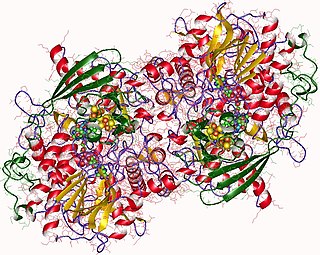| phosphoadenylyl-sulfate reductase (thioredoxin) | |||||||||
|---|---|---|---|---|---|---|---|---|---|
| Identifiers | |||||||||
| EC no. | 1.8.4.8 | ||||||||
| CAS no. | 9068-63-7 | ||||||||
| Databases | |||||||||
| IntEnz | IntEnz view | ||||||||
| BRENDA | BRENDA entry | ||||||||
| ExPASy | NiceZyme view | ||||||||
| KEGG | KEGG entry | ||||||||
| MetaCyc | metabolic pathway | ||||||||
| PRIAM | profile | ||||||||
| PDB structures | RCSB PDB PDBe PDBsum | ||||||||
| Gene Ontology | AmiGO / QuickGO | ||||||||
| |||||||||
In enzymology, a phosphoadenylyl-sulfate reductase (thioredoxin) (EC 1.8.4.8) is an enzyme that catalyzes the chemical reaction
- adenosine 3',5'-bisphosphate + sulfite + thioredoxin disulfide 3'-phosphoadenylyl sulfate + thioredoxin
The 3 substrates of this enzyme are adenosine 3',5'-bisphosphate, sulfite, and thioredoxin disulfide, whereas its two products are 3'-phosphoadenylyl sulfate and thioredoxin.
This enzyme belongs to the family of oxidoreductases, specifically those acting on a sulfur group of donors with a disulfide as acceptor. The systematic name of this enzyme class is adenosine 3',5'-bisphosphate,sulfite:thioredoxin-disulfide oxidoreductase (3'-phosphoadenosine-5'-phosphosulfate-forming). Other names in common use include PAPS reductase, thioredoxin-dependent, PAPS reductase, thioredoxin:adenosine 3'-phosphate 5'-phosphosulfate reductase, 3'-phosphoadenylylsulfate reductase, thioredoxin:3'-phospho-adenylylsulfate reductase, phosphoadenosine-phosphosulfate reductase, adenosine 3',5'-bisphosphate,sulfite:oxidized-thioredoxin, and oxidoreductase (3'-phosphoadenosine-5'-phosphosulfate-forming). This enzyme participates in sulfur metabolism.






